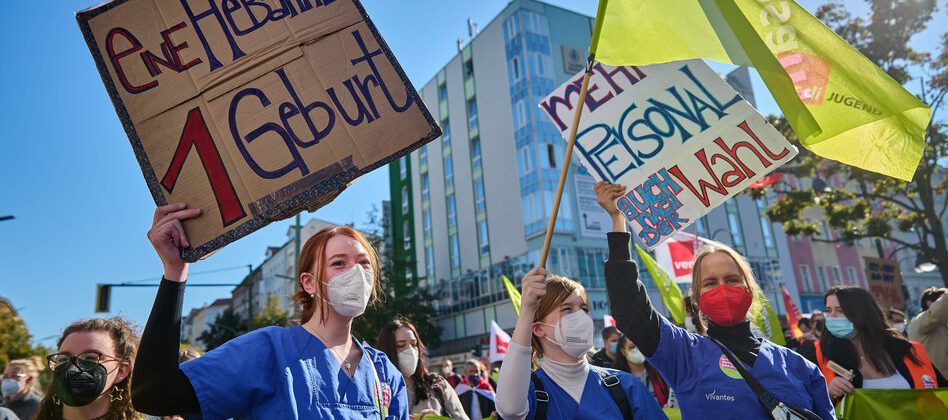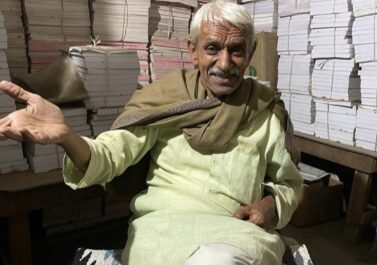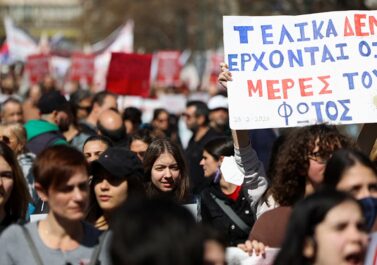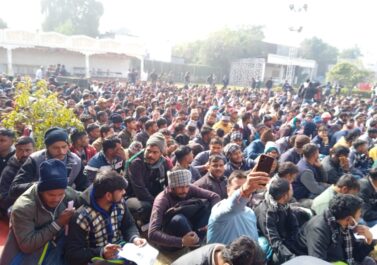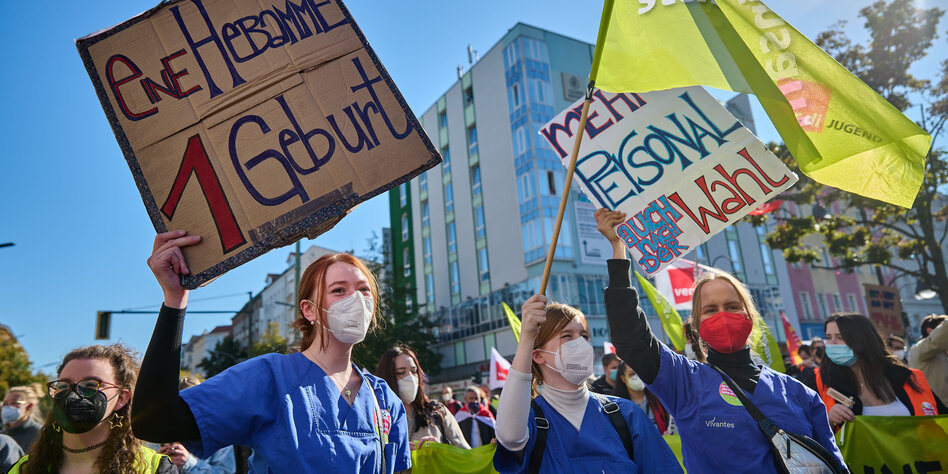
We’ve translated this article, originally published by comrades from Communaut, for the debate within the current NHS strikes. Previous reflections on strikes in Germany can be found here. Preliminary thoughts on the current NHS strikes here. A great documentary on recent health workers strikes in Germany can be found on Labournet.tv, unfortunately without English subtitles.
_______________________________________________________________________________________________________________
The strike in the state-owned Berlin hospitals 2021 will go down in the history of the hospital movement for its length of more than 30 days alone. It was also remarkable that the focus was not on wage levels but on the catastrophic staffing situation in the hospitals. For the first time, the workers of the two largest hospital operators Vivantes and Charité went on strike together for a relief collective agreement (addressing primarily the staff – patient ratio) and the application of the collective agreement for the public service (TVÖD) in the Vivantes subsidiaries. Ver.di, with dozens of organisers, set up different structures during the strike to motivate individual workers and actively involve them in the strike action. The result of the collective agreement was hailed from many sides. According to ver.di negotiator Melanie Guba, a “milestone of relief” was to be set with the collective agreement at the Charité. In contrast to previous collective agreements, the colleagues succeeded above all in obtaining either financial compensation or additional days off to compensate for the strain of understaffed shifts.
What is the current situation on the wards? And what has remained of the dynamics of the strike for the workers? We talked about this with a nurse who has been employed at the Charité for over twenty years and has worked on various wards.
***
More than a year after the strike, what do things look like at work? Has the staff situation on individual wards really improved and has the agreement been implemented?
There are definitely areas where the situation has improved. However, we also hear quite often that, as many of us expected, nothing has really improved in terms of relief through more staff in this quite short time. Recently, the press has mainly reported on the situation in the paediatric wards, because there, too, the agreed staff-to-patient ratio was implemented in almost none of the shifts. Colleagues in oncology, for example, report that about half of the beds have been closed in order to keep the ratio. Currently, colleagues from other countries are being recruited on a massive scale, which in turn brings its own problems and often leads to a different workload on the wards. Despite its locational advantage (attractive location, size), the Charité manages at best to compensate for the high turnover of nursing staff by recruiting new staff, but is not in a position to build up staff significantly. Nevertheless, the collective agreement should be seen as a certain relief. Previously, colleagues were usually told by their superiors that they had to organise themselves better, for example, when they indicated in a hazard report (Datix) that they felt overworked. This was simply dismissed as a subjective feeling. You don’t have to listen to that kind of nonsense anymore with the ratios that are automatically recorded. In addition, there are these ChEP points (Charité relief points). If the staff-patient ratio agreed in the collective agreement is not reached in a shift, the colleagues concerned each receive a ChEP. These, in turn, can be converted into days off to a limited extent or saved up. In this respect, what has been agreed is being implemented at the Charité. The commission that is supposed to determine staffing rules for areas not yet covered by the collective agreement is also working regularly. As far as we hear from the colleagues at Vivantes, they are experiencing far greater disappointments.
Is it realistic that colleagues can really take their time off when they have accumulated the corresponding stress points, or does it only exist on paper?
The Charité, wisely anticipating that many such relief days would arise, had it written into the collective agreement that their number would be limited. Thus, in 2022 only five relief days per registered or qualified staff could be claimed; in 2023 it is to be ten and in 2024 then fifteen. The ChEPs accrued over and above this can either be saved for a sabbatical, which lasts a maximum of three months, or for the colleagues to escape to retirement a few weeks earlier, subject to some bureaucratic requirements. To a degree limited by tax law, it is also possible to convert ChEPs into money. Personally, I do not find any of the latter options attractive. In these alternatives, unfortunately, the danger is inherent that superiors will be in your ear to save up points rather than convert them into days off. A certain amount of steadfastness is needed to enforce the days off. In order to counteract the pressure on staff that is intensified by this system, the Charité asks the nursing staff to work additional so-called ‘stability shifts’. Because they are very well paid, many colleagues actually do these shifts. This in turn leads to more disputes on the wards among colleagues. Many find it scandalous that work in additional shifts is suddenly supposed to be worth much more, and expect colleagues on stability duty to work more. On the other hand, it is always a point of contention whether, after having worked their additional stability shift, the colleagues are much more exhausted once they are back on their own ward. In addition to the additional duties, the Charité is thinking aloud about making working hours more flexible, such as extending shifts to twelve hours. Even more blatant is the attempt to get nursing staff who have found a job within the Charité that is no longer directly at the patient’s bedside to return to normal ward duty. They talk about demographic-friendly jobs, but they absolutely want to bring colleagues back into patient care who have found their niche with less physically demanding activities and without shift work for health or private reasons. The demand from the board of the Charité to more or less directly ban agency work in nursing also fits in with this. Because in nursing, temporary employment agencies often offer better working conditions and pay more. What the whole thing is supposed to have to do with relief remains a mystery. Moreover, the Charité can of course determine how many patients it admits for treatment. This is what is meant by the bed closures just mentioned, but there are of course limits to this, since the Charité is supposed to be profitable and closing beds is disadvantageous for patients, some of whom have to put up with longer waiting times. In this respect, it is not realistic to grant additional days off if the clinic wants to offer a similar service level. This would require an additional workload through the back door, especially in the form of stability shifts. Nevertheless, the days off are important as a kind of compensation for pain and suffering.
You mentioned earlier that there are problems when colleagues are recruited from abroad. What does that mean exactly?
For one thing, I think it’s a disgrace when rich Germany poaches trained professionals in nursing, especially since I assume that the guidelines set out in the UN are hardly ever adhered to. After all, nursing staff are not only recruited for German patients through state agreements, but clinics also do this on their own. The colleagues bring different language skills with them and have worked in other care models with a correspondingly different division of labour. This leads to misunderstandings time and again. They need training for quite a long time and have to improve their language skills alongside their work. In any case, it takes some time before the new colleagues are actually perceived as a relief.
As you already mentioned, the collective agreements at Charité and Vivantes have been implemented very differently. What are the main differences?
The collective agreements contain rather complicated regulations, some of which revolve around the fact that a software program automatically compares patient occupancy and the staff assigned to a ward. This software actually worked at the Charité at the start of the collective agreement. The management of the state-owned Vivantes group wanted to be particularly precise and introduce a system that recorded the ratio to the minute. One consequence was that no recording system existed at all until the summer of 2022. On the other hand, the minute-by-minute accounting ensured that in the times of handover, when, for example, the early duty nurses and the colleagues from the late duty are together on the ward, the ratios are suddenly fulfilled, but the colleagues start their actual work again a short time later clearly understaffed. Colleagues from Vivantes report that they are transferred at short notice from a regularly staffed shift to other wards in order to at least partially compensate for the shortage there. The areas specified in the collective agreement for which there were no ratios when the collective agreement on relief (TVE) was signed (for example, radiology and dialysis) are still being negotiated at Charité, but at Vivantes there seems to be a real standstill. The management of Vivantes is behaving like real arseholes towards the nursing staff, but compared to the way they treat the colleagues in the subsidiaries, it seems almost friendly.
Both permanent staff and workers from the subsidiaries took industrial action together, but at the Vivantes subsidiaries the demand for a TVÖD (being paid like in the public sector) was in the foreground. According to the press, colleagues there are now voting with their feet en masse and quitting in the knowledge that they would earn more elsewhere. How do you assess the course of the very slow negotiations?
The strike ended with a collective agreement for the subsidiaries that is based on the TVÖD and provides for gradual wage increases, but does not reach the wage level of the TVÖD. Moreover, not all subsidiaries are treated equally. But since the agreement Vivantes has been arguing with ver.di and withholding larger parts of their wages from the colleagues who are supposedly so valuable to them. Some bonuses have been cancelled without replacement. In addition, Vivantes is haggling over the wage grades and job evaluations. From the colleagues’ point of view, they are to be placed in wage groups that are too low. Apparently, Vivantes is also cancelling previously granted bonuses with the new grouping, for example in the area of cleaning. At the same time, Vivantes wants to divide the colleagues and is planning to put new staff in a lower group. As far as I know, the drama was not over by the end of 2022. This could well be Vivantes’ calculation, because without an agreement with ver.di, each colleague will have to sue for their rights individually.
Would the strike have had to last longer to get the workers back into the parent company?
The strike should definitely have been longer. Both the goals of relief and the introduction of the TVÖD for the subsidiaries had not yet been securely achieved. Nevertheless, it has to be said that the nursing staff were on strike for four weeks and the colleagues in the subsidiaries for another two weeks. That is quite exhausting. In addition, there was a collection to financially support the strikers at the subsidiaries, but of course the strike money does not completely compensate for the wages. Especially those who don’t have much in terms of reserves and savings have to think about how long a strike can last. My feeling was that, before the Charité signed the collective agreement, the strength of the colleagues would probably have been enough for a few more days of strikes, but with the signature the end was sealed. Whether the time would have been enough to negotiate a better collective agreement remains speculative. However, the colleagues apparently felt that not much more was possible and voted accordingly to suspend the strike.
Is leaving the job currently the only form of protest? To what extent can these difficulties in implementation be used to push the struggles further?
Yes, at the moment the protest is mainly expressed in the fact that the (often female) colleagues are leaving the subsidiaries. Since the collective agreement is based on the TVÖD, there is the possibility of taking joint industrial action again in the current round of collective bargaining, focusing on the issue of wage levels. Unfortunately, the collective agreements are drafted in such a way that the agreed wage increases would only ever reach the colleagues of the subsidiaries with a time lag. Nevertheless, my hope would be that this year’s round of collective bargaining will once again bring us together in large numbers on the streets and on strike, so that the common ground is not so quickly forgotten. Because for almost twenty years, politics and bosses have divided us nicely.
In recent years, Ver.di has tried very hard to have a different form of member participation in the collective bargaining disputes. The keyword here is ‘strike university’ in the form of workshops for exchange and political discussions. Delegates and so-called ‘collective bargaining advisors’ (also a kind of team delegate) are appointed by the teams to accompany negotiations, they inform their teams and, in the best case, pass on the teams’ demands to ver.di. What do the colleagues think about the organisation of the strike and what has changed for them in the longer term as a result?
Up until the collective bargaining movement, the union approached us with a top-down style, i.e. union officials set targets and the pace. With the collective bargaining advisors, a path was taken in which the active colleagues can get much more involved. This has actually led to a certain (participatory) dynamic in the wards. Ideally, the bargaining advisors were elected by their teams and the teams discussed the matter. In 2021, this went so far that the team delegates, as the former bargaining advisers are now called, accompanied the negotiations very closely and were continuously informed by the bargaining commission. I have the impression that this was perceived as a good thing by many and led to sustained activity on their own part. In preparation for the collective bargaining, many are more interested than usual and take part in meetings, even if not yet at the level of 2021. In this respect, something like a team delegate structure definitely makes sense. However, whether such a structure is sufficient to actively challenge decisions made by union officials cannot yet be judged conclusively. Moreover, I think it is normal that the structures that emerge in an industrial dispute crumble again afterwards. That was probably the case at the Charité.
How did the colleagues experience the organisers and what remained of the dynamic that was created by them?
Without the organisers, the strike would not have happened. Especially in the beginning they were necessary to activate the colleagues. They gained a position of trust, if only because they were always around and approachable. At the same time, the official organisers planned large parts of the campaign, including the election of team delegates, the big meetings, demonstrations, etc. All very important for the momentum to build up a campaign. All very important for the dynamics of tackling such a long strike. But in my eyes this has also meant that the team delegates have too rarely questioned decisions and proposed arrangements. In my opinion, it would have been better if the organisers had withdrawn a bit more after the initial phase, especially in questions of content, in order to give the colleagues more room for their own development. Strikes must emancipate. Organisers are employees of a company commissioned by ver.di. This means that there is always a danger that the bureaucratic levels of ver.di will exert a strong influence on the opinions of the colleagues through the organisers. When the organisers express opinions, they usually carry more weight than when a nurse speaks. Colleagues are not used to questioning things and often prefer to stay in the consumer role, at least in my experience. The team delegates are a good idea to break this up, but it hasn’t quite happened yet.
Were there, or are there, attempts among the workers to organise independently beyond the trade union apparatus?
I would say that there are very few such attempts nationwide. All the groups I know of are made up of very few people. This seems to me to be an expression of the problem I have just described.
In the meantime, workers in more than twenty clinics nationwide have won collective agreements to reduce the workload. Do you have contacts in other cities and how are you networked?
Yes, there are contacts. Networking is mainly done through ver.di or also through supporting groups outside the clinics such as the alliance “Health not Profits”. These contacts can certainly be expanded.
How do you assess the strike support from the Berlin population and what would you wish for future disputes?
Actually, we had the feeling that we had a very broad support within the Berlin population. That means, on the one hand, meetings with the so-called ‘city society’, in which a lot of people and also initiatives took part. At the same time, we have also received a lot of positive feedback and support from family, friends, patients and relatives. The last collective dispute was about relief and thus also about improving patient care. And everyone knows that they can quickly become a patient. In 2023, it is now about our wage level and an inflation adjustment. We know that many Berliners are in a similar or even worse financial situation than we are. That’s why we don’t want our wage demands to be seen as greedy. For us, they are the absolute minimum wage increase for all workers and aid recipients. We hope that there will be powerful joint actions, for example with the colleagues at the Berlin municipal cleaning service, to push through our demands, and that the Berlin population will also take to the streets with us.
In October 2022, the doctors at the Charité also went on strike. What were the connections to the relief movement for better staffing ratios and what about the solidarity between different professional groups?
The doctors at the Charité have their own collective agreement through the Marburger Bund. In principle, the relationship between doctors and nurses is difficult as far as collective bargaining is concerned. On the one hand, due to the observation that the wage demands of the doctors’ colleagues have been met in recent years even without industrial action à la “doctors don’t have to strike”. On the other hand, during our strike for better staffing ratios, many a chief physician or senior physician attracted negative attention by putting pressure on the nursing staff to perform better than was possible due to the strike emergency staffing. Last year, the doctors demanded not only more pay but above all better working conditions, and here we would actually have an overlap, because both their and our working conditions are so unbearable because of the flat rates per case-system (hospitals receive a fixed amount for each individual treatment, which is supposed to motivate them to do it as efficient as possible). There is a lot of understanding on the part of the nursing staff for the demands of the assistant doctors, but unfortunately this is rarely expressed in actual solidarity among the individual nursing staff. At the same time, it has to be said that the solidarity among the occupational groups that maintain a clinic could, on the whole, be better.
What do you expect for the upcoming collective bargaining dispute as far as the motivation of your colleagues is concerned?
The pressure is very high because of the increased cost of living, so I hope that the colleagues are properly motivated. However, there are already fears among the colleagues that the bargaining committee will be satisfied with too little or that the employers will take refuge in arbitration. In contrast to the collective bargaining relief movement, this is now a nationwide collective agreement and experience shows that there is less direct influence from the ward-floors. This could also have a negative effect on the motivation of the colleagues. We will have to wait and see. The next strike day is on 9 February. Many colleagues have already made it clear that they want to take to the streets for their demands.
